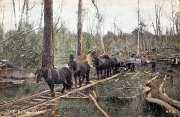Timber has always been a major construction material in Australia. With the discovery of gold in the
1850s, rapid development commenced in many parts of the country. This led to a huge demand for building materials. Taking
advantage of fine stands of excellent hardwood in virgin forest, one of the major challenges facing the early sawmillers was
transport.
Their problem was how to get this timber to the nearest railway, river or port. In winter roads were
impassable and road metal was impossibly expensive. But the pioneers' ability to improvise lead to the construction of timber
tramways. On closely packed sleepers wooden rails were laid, and trolleys, drawn by horses, carried the logs and sawn timber
to the nearest railway station or jetty. During winter, many timber tramways also provided farmers with the only means of
getting produce to the market.
As the timber industry developed the tramway networks grew. Steam locomotives and steel rails began
to be used on some lines. Isolated sawmilling settlements in the depths of the forest were totally dependant on the tramways
for their every need.
Ingenuity and economy characterised these tramways. Earthworks were kept to a minimum by extensive
use of timber trestles, gullies were spanned by tall but flimsy bridges. Steep grades were surmounted by use of winches. It
was in the 1940s that the construction of logging roads in forest areas led to the wholesale abandonment of the tramways.
Today physical relics of these tramlines are rapidly decaying. Bridges are collapsing, thick vegetation
grows on the roadbeds, while bulldozers have permanently destroyed many of the earthworks. But in some cases the tramway formations
have been cleared to make excellent walking tracks.
Timber tramways operated in all states of Australia with the apparent exception of South Australia,
where the dry climate did not lead to the growth of dense forests of tall hardwood trees. In Western Australia large companies
were formed to extract the timber, and their tramways tended to be more sophisticated than those in the eastern states. The
densest, most complex networks of tramways probably occurred in Tasmania and Victoria, in the areas about 80 km to the south
of Hobart, and 80 km to the east of Melbourne.
Warburton
Forests
In the
early days, many of the sawmills built their own wooden or steel tramways to carry sawn logs into the La La sidings, or shared
existing tramways with other sawmill compnies. Some of these ran along or at the edges of council roads.

